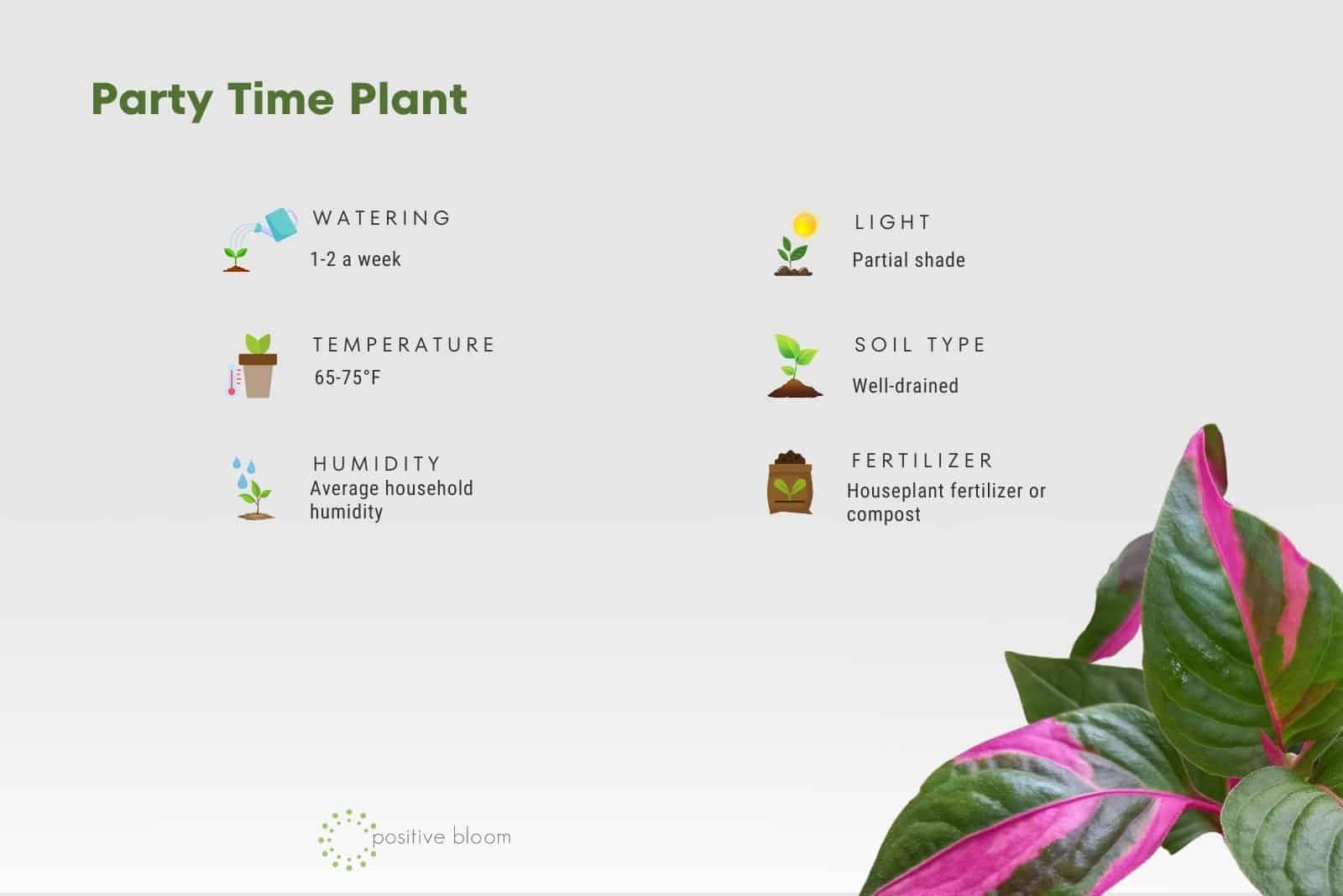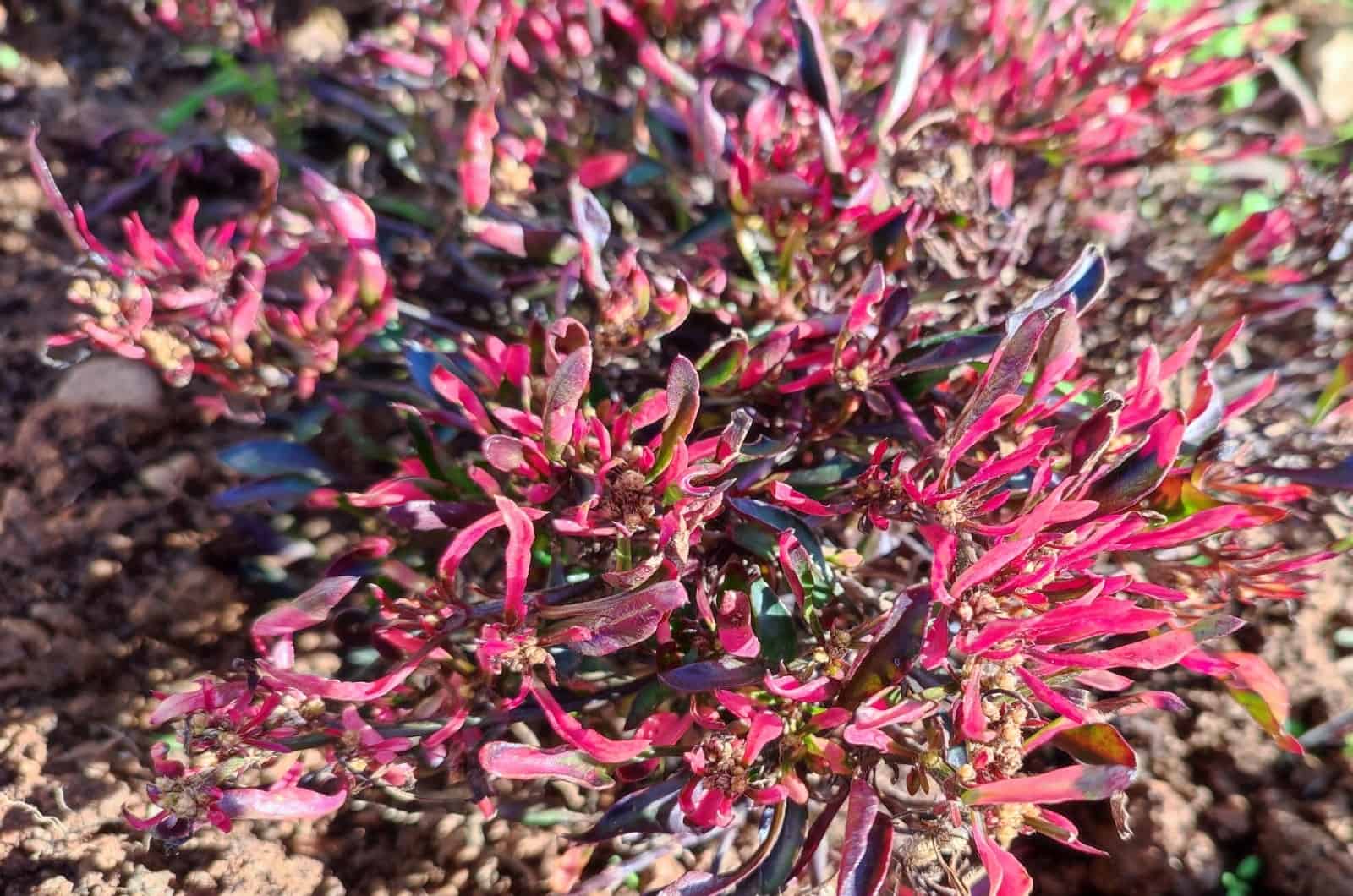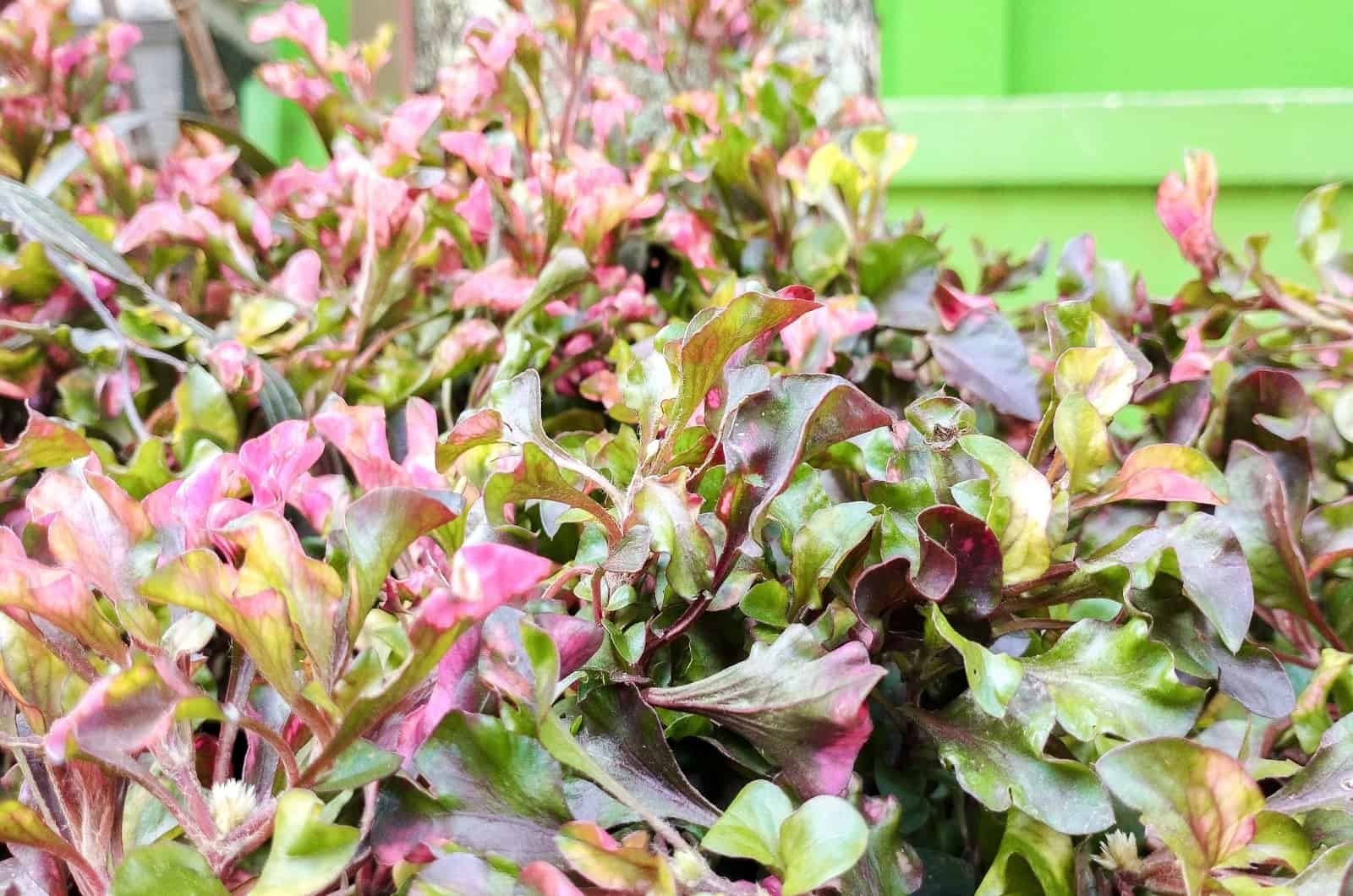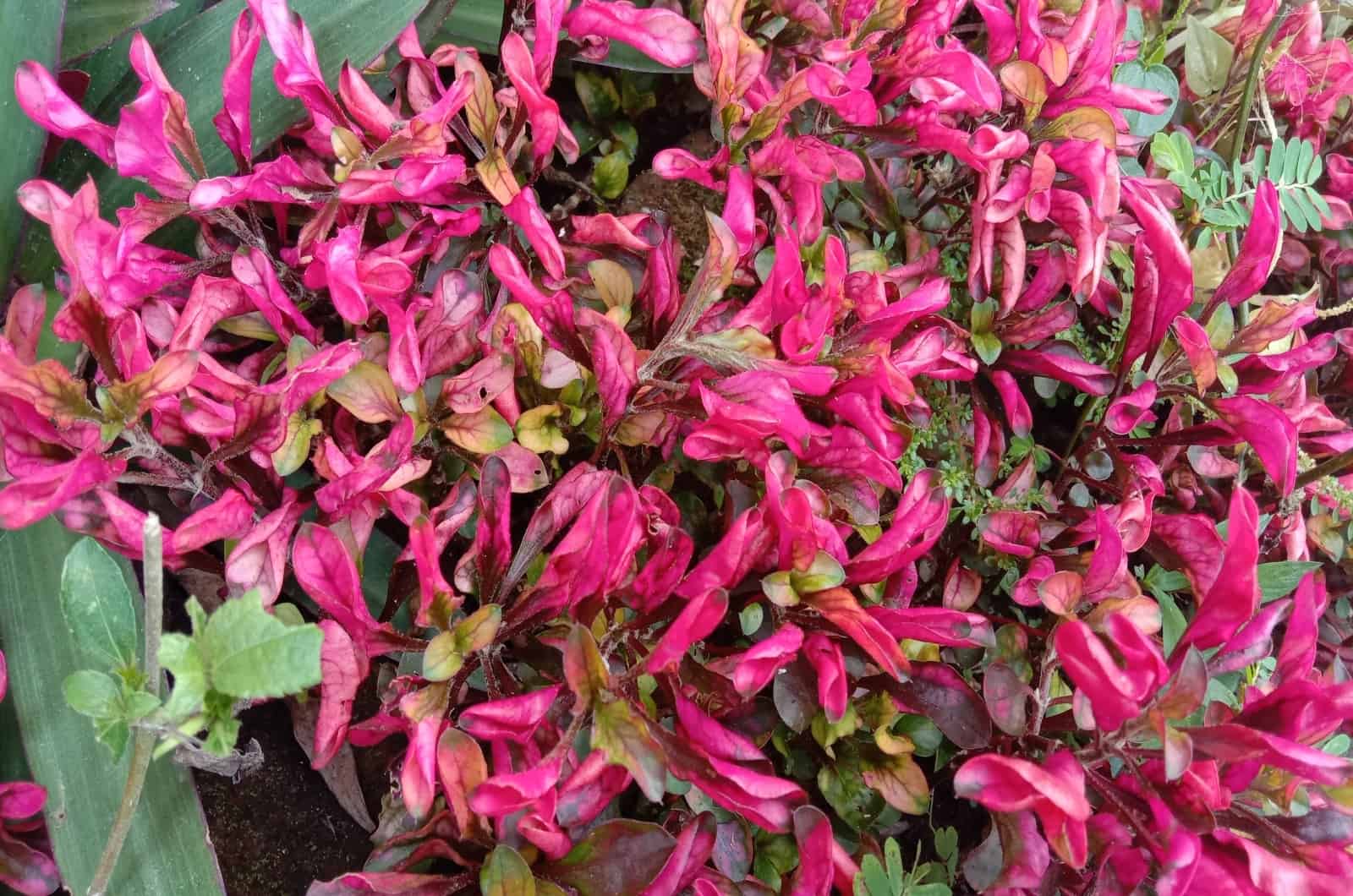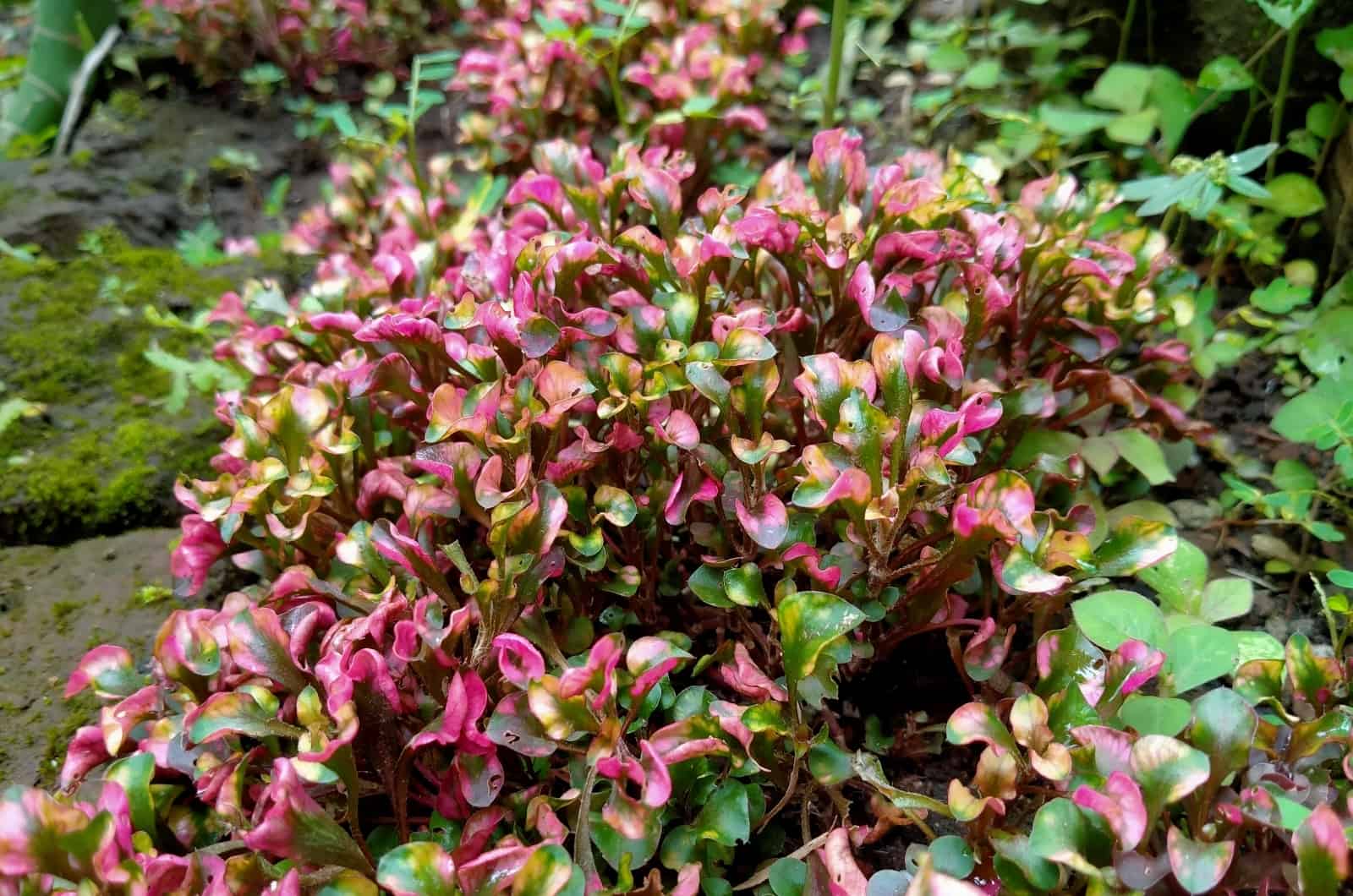The colorful party time plant is everything that a garden needs. You can grow it indoors or outdoors, but you should be mindful of its preferred hardiness zone.
It is a bright pink, cultivated variety that requires little care for its unique colors to shine.
Of course, if you want it to live for a long time, you should meet all its requirements, and we’ll discuss them all in the following sections.
We’ll also include some common issues you might have to deal with, such as pest infestations and disease infections, so that you can be prepared for everything.
Before we get to all these things, let’s look into the main information about this plant:
[table id=632 /]
Party Time Plant Care
The party time plant is a perfect houseplant as it can thrive in partial shade, well-drained soil, and average household humidity.
You should water it whenever its growing medium begins to dry out, and feed it from time to time to enjoy its beautiful variegations.
Repot it when it becomes too big for its container, and only prune the unsightly foliage.
Of course, plant care involves a bit more than this, and we’ll discuss everything you need to know about this plant’s requirements below.
Light Requirements
The party time alternanthera needs partial shade to exhibit the most vibrant variegations. If you keep it in full sun, it can lose some of its bright pink color and the hot midday sunlight can burn its mesmerizing foliage.
Instead, place it in a high-light location that gets sun in the morning or in the late afternoon (such as an east or south-facing window), as the direct sunlight isn’t that harsh then.
This plant cannot tolerate low-light levels, so make sure to use artificial lamps to help it grow if you don’t have any sunny windowsills available. However, grow lights can hurt plants, so make sure to place them at least one foot away from your alternanthera.
And if you only have a west-facing window, you should close the curtains or place the party time plant several feet away from it to keep it safe.
Finally, if you live in a warm climate, you can grow this plant outside all year long; just make sure it gets direct sun in the morning or late afternoon, and some shade at midday.
Water And Humidity
This plant requires evenly moist soil, so you should water it deeply whether you grow it as an in-ground or container plant.
Make sure the potting soil gets a bit dry at the top before hydrating it. Generally speaking, you might need to water your party time alternanthera 1-2 times a week, depending on the soil type you grow it in and the amount of light it receives.
Also, avoid keeping its root zone wet all the time, as that can lead to root rot and loss of variegation. Instead, you can discard the water that accumulates in the tray, or plant this alternanthera in a raised bed.
Finally, the best time to irrigate your plants is in the morning or late afternoon when the moisture won’t quickly evaporate, but still be gone before the night arrives.
Humidity
The party time plant can tolerate average household humidity quite well, so you won’t have to worry about getting a humidifier or remembering whether you ought to mist it.
However, if you do live in an arid climate, you might want to raise the relative air moisture up to 40-50% because you don’t want the leaves of this gorgeous plant to shrivel, turn brown, and become crispy.
Temperature
This plant isn’t really cold-hardy and can die if exposed to cool temperatures for a long period of time. It can tolerate temperatures down to 55°F, but it generally prefers temperatures between 65-75°F.
It probably won’t be able to bloom in these conditions, but it will stay alive and keep its bright pink foliage.
You should also avoid keeping this cultivar in drafty areas, such as near old and cracked windows, doors, AC vents, heaters, etc.
Not only do they stress out the plant with constant temperature fluctuations, but also lower the humidity levels, which can be harmful if your relative indoor humidity is low.
Soil And Fertilizer
This plant doesn’t need any particular soil type, but you should ensure that its growing medium is well-draining.
You can get such potting mixes in any garden center, or you can get a regular one and add some draining materials such as perlite, pumice, or even small pebbles.
After planting it, you can add a thin layer of mulch to hinder root growth, maintain proper temperature around the root zone, and retain moisture.
Fertilizer
If you use store-bought potting soils and repot this plant whenever it doubles its size, you won’t need to feed it at all.
However, if you do want to give it a little bit of boost, you can apply some houseplant fertilizer, just be sure to follow the instructions on the packaging.
You can also add some organic matter, but compost and fertilizer differ in that the former can also amend the soil and improve its structure, whereas the latter simply adds more nutrients.
Therefore, you can use compost to improve the fertility of your growing medium and introduce the minerals necessary for the plant’s proper growth.
And if you opt for fertilizers, remember to apply them only during the growing season and always water your alternanthera plant afterward.
Propagation Of The Party Time Alternanthera
You can easily propagate the alternanthera from a mature plant by taking cuttings.
Here’s how:
Step 1. Take a couple of healthy cuttings and ensure they have at least two nodes since that’s where the roots and new leaves will grow from.
Step 2. Cut the lower foliage and place the cuttings in a glass vessel filled with water.
* If you leave the bottom foliage on, it’ll rot and contaminate the water.
Step 3. Place the jar in a bright spot, and the root system should develop in a week or two.
Step 4. Once you notice long roots that aren’t transparent anymore, you can repot your new plants in the soil. Take a container with drainage holes, place some well-drained soil in it, and plant your alternanthera.
* Repot this plant in moist soil to alleviate transplant shock, and also keep it in bright light.
Here are some more tips on party time alternanthera propagation:
Repotting The Joseph’s Coat
If you don’t fertilize your plant, you should repot it at least once a year in order to give it the nutrients it requires for proper growth.
However, if you feed it regularly, you won’t have to move it to a larger container unless you notice it has overgrown the old one.
Furthermore, the best time for repotting is during its growing season, so make sure you do it in spring or summer. This way, the plant will adjust to its new home before entering dormancy.
Take a new, larger container, place some potting medium in it, put your plant in, and cover its roots with more soil.
Pro tip: Always repot or transplant your plants on a cloudy day to alleviate the transplant shock, and then water them thoroughly.
Pruning The Alternanthera Ficoidea ‘Party Time’
The good news is that you don’t have to prune this plant in order to prolong its lifespan (like you do with lavender, rosemary, etc.).
However, if you want to make it bushier, you can pinch its tops as it grows. And if it becomes uncontrollable, you can always take some secateurs and start snipping.
There are some excellent pruners for arthritic hands out there for if you have weak hands or some extensive pruning to do; these garden scissors have ergonomic handles and help you get the job done with minimal fatigue.
Finally, you should always remove old, dead, burnt, and diseased foliage since they only waste the plant’s energy and take up the room where new growth could be.
Common Issues With The Party Time Plant
Unfortunately, this plant isn’t resistant to pests and fungal diseases such as root rot. Therefore, you should ensure it gets first-class care.
Healthy plants are less likely to be infested with insects, and those that receive the right amount of water certainly won’t get infected with root rot.
Let’s take a look at what you can do if it does ever come to this!
Pets
The most common pests that colonize the party time plant are aphids, mealybugs, spider mites, whiteflies, slugs, and caterpillars.
Luckily, you can get rid of all of them by using horticultural oils, insecticidal soaps, or some stronger pesticides.
And if you have a slug and snail problem, you can sprinkle some coffee grounds around your plant (or dilute them and spray it with the solution) to keep them at bay.
Diseases
One of the most common diseases that afflicts plants all over the world, including the party time alternanthera, is root rot.
We cause it by overwatering plants, so it’s easy to avoid; we simply need to irrigate our plants when the soil gets a bit dry at the top (at least with this one).
However, if you notice symptoms such as yellow discolorations, droopiness, slow growth, and a rotting smell coming from the growing medium, you should examine this plant’s roots.
If they are mushy, soft, and brown or black, you should immediately remove them. Then, spray everything with a fungicide to avoid the return of the disease, and plant it in fresh soil.
Pro tip: You should examine the differences between copper fungicide and neem oil, as the former can be used as an insecticide and a fungicide, while the latter is just a fungicide. Of course, copper fungicide is more efficient, but neem oil can keep your plants safe as well.
FAQ
Why is the alternanthera plant called “party time”?
The alternanthera plant got its name due to its amazing variegations, as it really does look like it belongs in a party!
Another common name is “parrot leaf”, which it got because its foliage resembles parrot beaks.
What does the alternanthera plant look like?
The main plant feature of the party time is its green, ovate, and pointy foliage with bright pink variegations. Some leaves can be entirely pink, while others contain splotches and patches of this unique color.
This plant can also produce creamy-white, inconspicuous flowers, but it soon dies after it does, so you should prolong its flowering as long as you can.
We often grow this alternanthera as a container plant, border plant, for mass planting, in hanging baskets, etc.
Final Thoughts
The party time plant is a unique cultivar that belongs on everyone’s wish list. Its green and bright pink leaves lure you in and make you unable to look away.
Another great thing about this plant is that you can grow it in partial shade for the best variegation, maintain moist soil, and grow it in a well-drained medium.
You only need to repot it once it becomes too large for its container; you don’t need to prune it unless you want to make it bushier, and you don’t need to regularly feed it.
On the other hand, it can get infested with pests and suffer from certain fungal diseases such as root rot, so you should make sure to care for it properly.
But if you still find yourself having to deal with these issues, you can simply use pesticides or prune the diseased parts.
Enjoy this splash of color in your indoor and outdoor garden, and until next time!


